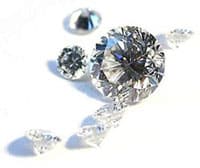While the 4 Cs remain the standard criteria within the jewellery world today, both within the parameters of these criteria and moving beyond. Colour is not seen as a ‘’quality’’, but rather as a subjective characteristic, and the brand accepts all diamonds within the D–-Z colour range as long as the colours are pure, without tints of brown or grey. In terms of clarity, we work only within the range from FL (flawless) to SI2 (slight inclusions), so that the diamond looks clean to the naked eye.
The “4 C” of diamonds
Carat
‘Carat’ refers to the weight of a diamond. Each carat is divided into one hundred points and is equivalent to 0.2 grams, a measurement adopted in the United States in 1913 and now universal. The name comes from the carob seed, used by early traders as near-uniform counterweights to balance their scales.
Clarity
Clarity indicates the presence (or lack of) inclusions inside the diamond, as well as external marks or blemishes. Most diamonds contain minute inner flaws or inclusions, often referred to as ‘birthmarks’, as they occurred during the long formation process of the diamond, over millions or billions of years under extreme heat and pressure deep within the earth’s core. Clarity is graded according to the visibility of inclusions or blemishes under tenfold magnification. The top grade, reserved for the rarest and most highly prized diamonds, is flawless (FL), showing no inclusions or blemishes. This ranges downwards through IF, internally flawless, meaning only blemishes and no inclusions; VVSI, meaning very, very slight inclusions, difficult to see under magnification even for an experienced grader; VS, or very slight; SI, slight; down to I, obvious inclusions which ultimately affect brilliance.
Color
In terms of colour, the finest white diamonds (as opposed to fancy coloured diamonds) should be as close to colourless as possible. Colour grading as defined by the GIA is classified by letters of the alphabet, the best being D, colourless, and continuing through G to J, near colourless, right down to Z. Colour gradations for each letter are subtle but clearly defined to the professional eye. The letter D was chosen to represent the top white diamond colour, as other pre-existing, imprecise and confusing classifications had used letters A, B and C among other labels.
Cut
Cut is the most crucial of the 4 Cs, Life and Brilliance of a diamond. Brilliance refers to the overall light reflected from a diamond; Fire is the dispersion of light into the rainbow colours of the spectrum; and Life is the movement of light within a diamond, or scintillation. Aside from the shape of the diamond, from the classic round brilliant to fancy cuts, a cut is evaluated on the precision of its critical angles, its symmetry, proportions and polish. Proportions concern the relationships between the different parts of the diamond: the table (top flat facet), the crown (visible top of the diamond), the girdle (the line or edge around the middle of the diamond) and the pavilion (the underside). These relationships can affect the way the diamond interacts with light.
The resistance and brightnes of diamonds, give your UNICA wedding bands the fashion of durability.
DIAMOND ETERNAL AND UNIQUE CHARM.
www.forevermark.com * Forevermark are Trade Marks of The De Beers Group of Companies.






